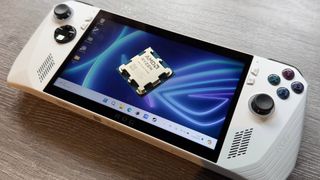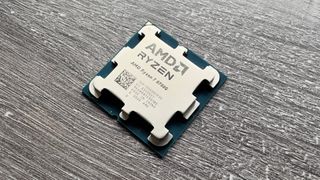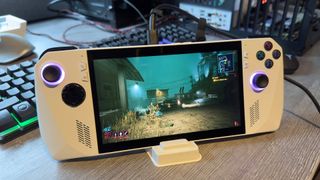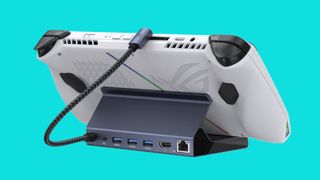Which is the best $700 AMD Ryzen gaming PC: a handheld or desktop PC?
Putting a Ryzen 7 8700G system in a head-to-head with the Asus ROG Ally to see what's what.

Let's say you were in the market for a new PC, but you couldn't afford to spend more than $700. You could go down the second hand route, though the lack of any warranties may well put you off. Lots of people go for a low-cost desktop PC with an APU—a CPU that has a decent integrated GPU. But hang on, don't all handheld PCs use an APU? They do indeed, which raises a simple question. What's worth the money, a portable PC or a desktop PC, if they're both using the same chip?
Mobile gaming PCs really took off last year, with offerings from Asus, Lenovo, OneXPlayer, and Ayaneo all trying to knock Valve off the top position for best handheld gaming PC. One thing they nearly all have in common is AMD, as the majority of models sold sport a Ryzen APU of one kind or another. The Asus ROG Ally, for example, houses the Ryzen Z1 or Z1 Extreme, which is a modified Ryzen 7 7840U laptop chip.
I have quite a soft spot for APUs so when AMD released an updated version of the aforementioned chip for the desktop market, the Ryzen 8000G-series, I couldn't wait to get my hands on one and start mucking about with. When the Ryzen 7 8700G finally dropped on my desk, I got to thinking about how it compares to the Ryzen Z1 Extreme and whether they'd be a good match, if one was looking to have a cheap gaming PC.
On paper, they're virtually identical. They both have eight core, 16 thread CPUs based on the Zen 4 architecture; they both have the same RDNA 3 GPU, with 768 shaders (12 Compute Units). Things begin to differ when you compare maximum clock speeds and power limits, though. Asus limits the APU in the ROG Ally to 30 W and only when plugged into the mains, but the CPU can still reach a boost clock of 5.1 GHz and the GPU can hit 2.7 GHz.
| Header Cell - Column 0 | Ryzen Z1 Extreme | Ryzen 7 8700G |
|---|---|---|
| CPU cores/threads | 8 / 16 | 8 / 16 |
| Base clock | 3.3 GHz | 4.2 GHz |
| Boost clock | 5.1 GHz | 5.1 GHz |
| L3 cache | 16 MB | 16 MB |
| TDP | Up to 30 W | 65 W |
| GPU Compute Units | 12 | 12 |
| Boost clock | 2.7 GHz | 2.9 GHz |
Like all of AMD's latest desktop APUs, the 8700G has a 65 W limit. You might think this permits much higher clock speeds, but the CPU limit is still 5.1 GHz and the GPU's only 7% higher at 2.9 GHz. However, the CPU base clock in the 8700G is almost 1,000 MHz higher than that in the ROG Ally. That won't matter if you keep the handheld plugged in and the clocks really only drop to the base level when constrained by power or temperature.
What the greater power limit really does, though, is let the processor maintain high clock speeds for longer, until the chip reaches a temperature limit and then gets throttled back. Both systems can boost to the same level, but the handheld's 30 W limit means it just can't sustain that for as long as the desktop chip.

One of the biggest differences to be found is in the memory configuration. The ROG Ally has four LPDDR5-6400 chips soldered onto its motherboard, for a total of 16GB, whereas I've been using two 16GB sticks of DDR5-6400 in the 8700G's board. With APUs, the CPU and GPU both share the same pool of RAM, so it's important to have lots of fast memory, to ensure games can run as well as they can.
The biggest gaming news, reviews and hardware deals
Keep up to date with the most important stories and the best deals, as picked by the PC Gamer team.
The low powered stuff in the Ally isn't the best stuff you can have, despite its high speed rating. I carried out a range of bandwidth and latency tests on both systems, and the handheld PC's average results were 57 GB/s at 251 nanoseconds; repeating the scenario for the 8700G gave figures of 68 GB/s and 173 nanoseconds. The desktop chip has much better latency, but it doesn't have significantly more bandwidth, apart from in very specific scenarios.
But, we're not here to talk about theoreticals. What we want to really see is whether it makes sense to spend $700 on a gaming handheld PC or put that money towards building an APU-powered desktop PC. So on to some benchmarks!
To start with, I ran Time Spy Extreme and Night Raid from 3DMark, with the expectation that the graphics scores for the two chips would be quite similar, but the CPU results would favour the 8700G. And to no surprise, that's exactly how things panned out. The higher power limit of the desktop Ryzen means the CPU section can maintain its boost clocks for longer, but it doesn't do much for the GPU part.
For game testing, I didn't plan anything comprehensive, just F1 22, Doom (2016 version), Horizon Zero Dawn, Cyberpunk 2077, and Skyrim: Special Edition. Because why the heck not. Well, as you can see below, the results were not quite what I was expecting.
First of all, F1 22 point blank refused to work on the ROG Ally, no matter what settings I tried, but everything else worked fine and in two of the games, it actually ran marginally faster than the Ryzen 7 8700G system. All of this was in-game testing, not a benchmark tool, and I confirmed the figures in several areas, across multiple runs.
The problem turned out to be the setting for the UMA buffer size in the 8700G's motherboard. This value controls how much of the RAM the graphics chip sees as VRAM, and I had initially conducted all of the testing with this set to Auto. However, on the ROG Ally, I had been using a value of 6GB, as the default value of 4GB was just a little too small. It does go up to 8GB, but that would take up half of the handheld's 16GB, leaving insufficient RAM for lots of games.
However, since the 8700G platform had 32GB in it, there was no problem about running out of 'normal' RAM for the game. So the UMA buffer size was set to 8GB and then everything was repeated. F1 22, Horizon Zero Dawn, and Cyberpunk 2077 ran noticeably better with the higher setting, but Doom and Skyrim were effectively unchanged.
Inspired by this success, I then tried the ROG Ally again, but this time with its UMA buffer size forced to the maximum 8GB value. Sadly, it made no difference to any of these games and F1 22 continued to sulk in the corner.
I've spent a fair bit of time just doing some general gaming on both systems and for the most part, the Ryzen 7 8700G system was typically smoother and easier to game on than the ROG Ally. The handheld could be quite picky at times about which games it was happy to run and even those that did, some of them spat out the dummy over the input system (i.e. touchscreen and gamepad controls).
So, just on the basis of this minor batch of tests, it's tea and biscuits for the 8700G and leftovers in a bowl for the ROG Ally, yes? Well, not quite.
Despite having a limit more than double that of the ROG Ally, the 8700G wasn't massively better in terms of outright gaming performance. As mentioned before, that 65 W limit helps the CPU maintains its boost clocks but since the GPU is relatively weak, most games are going to be limited by the graphics processor.
It's worth noting that the ROG Ally can only run with a 30 W limit when plugged into a charger—remove that and the limit drops to 25 W at best, which rapidly eats into the battery's lifespan, though performance relatively unaffected. Use the 10 or 15 W modes, though, and games take quite a hit in frame rate.

The desktop APU also had double the amount of RAM to work with, and it has more bandwidth and better latencies. Asus had to make everything as power light as possible for the ROG Ally, whereas there was no such restriction with the desktop PC.
Unfortunately I didn't have a spare 16GB DDR5-6400 kit to hand to make things more equivalent, but I would expect the 8700G to run into the same balancing problem between UMA buffer size and free RAM for games as the ROG Ally.
Asus also had to make its handheld relatively affordable, whereas the 8700G was in a test platform that has various components which would be overkill for a typical APU setup. Where the Ally costs $656 on Amazon at the moment, the combined price of all the parts that made up the other system comes to around $1,200—and that's not including the monitor and input devices.
Obviously it's not hard to make a variety of changes to chop that cost right down and get it near that of the ROG Ally, but if you want to include a good monitor in a $700 limit, you'll begin to impact performance by having to use slower RAM and storage.

But it's not particularly expensive to add a docking station for the ROG Ally, to make it convenient to attach a monitor, mouse, and keyboard. Just $40 gets you an iVANKY model, with one LAN, one HDMI, and three USB ports. If you've already got a 1080p monitor, as well as a suitable keeb and mouse, then it's a piece of cake turning the Ally into a perfectly serviceable, if rather noisy, desktop PC.
I can't really turn the 8700G system into a handheld device!
But what a desktop computer lacks in portability, it more than makes up with flexibility—need more storage? Most AM5 motherboards come with at least two M.2 slots and four SATA ports. Need better graphics? Easy to jam a new GPU in and switch over to that, instead of using the integrated Radeon 780M. Want total silence while gaming? Just use a high end cooler and turn the fans right down, as the 8700G barely gets hot.
None of this is to diminish what the ROG Ally is good at, i.e. being a portable Windows PC for gaming, and with the right accessories, it can turn its hand to being a little desktop of sorts. But if it was my money, I'd put it all on a nice little Ryzen 7 8700G setup—it's plenty fast enough for 1080p gaming and you don't need to spend a fortune on the rest of the setup to have a great starter PC.
If you're planning on doing the same, just make sure you pair it with as much of the fastest RAM you can afford, and the motherboard supports. That way, you'll be giving the little GPU inside the APU the best chance it has of reaching its full potential.

Nick, gaming, and computers all first met in 1981, with the love affair starting on a Sinclair ZX81 in kit form and a book on ZX Basic. He ended up becoming a physics and IT teacher, but by the late 1990s decided it was time to cut his teeth writing for a long defunct UK tech site. He went on to do the same at Madonion, helping to write the help files for 3DMark and PCMark. After a short stint working at Beyond3D.com, Nick joined Futuremark (MadOnion rebranded) full-time, as editor-in-chief for its gaming and hardware section, YouGamers. After the site shutdown, he became an engineering and computing lecturer for many years, but missed the writing bug. Cue four years at TechSpot.com and over 100 long articles on anything and everything. He freely admits to being far too obsessed with GPUs and open world grindy RPGs, but who isn't these days?
Most Popular


